|
July 19 continued
We drove on to Leopard Rock, a large ridge that rises up
out of the flat plain. With many rocky outcroppings, caves and
brushy areas, it is an ideal place for a leopard to hide her cubs.
A small sign on a tree identifies Leopard Rock, and the track
around it is signposted as Leopard Drive. We drove around it
slowly, scanning for a feline shape. Gee told us that a female
leopard had been hanging around the area recently, and he thought
she might have cubs.
|
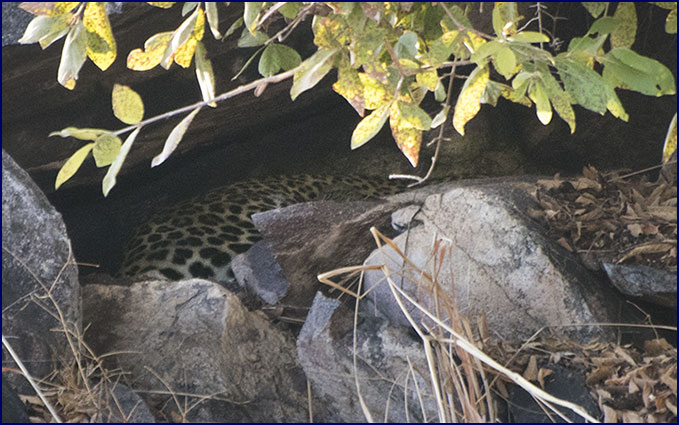
A
glimpse of the leopardess in the cave. |
Going around to the back of the ridge, we came to a small
cave under a tree, part way up the side of the cliff. Using our
binoculars, we could just barely make out the sleek spotted coat
of a leopardess. We watched her for a while but there was no
movement; she appeared to be sleeping. Gee said she must have a
baby in there, and we would come back later to check on her. We
moved on.
A bateleur eagle flew overhead, recognizable by its broad
head and short tail. Bateleur is the French name for a tightrope
walker, and watching this graceful bird of prey swaying gently
from side to side as it rode the thermals, wing tips spread and
lifted up for balance, I could see how the name fit.
A tall slender bird with variegated feathers walked through
the underbrush; Gee identified it as a northern black korhaan. A
black-winged kite flew high above, hovering and diving, its black
and white markings vivid in the sunlight. A little bee-eater
perched on a twig, shining brilliant green and yellow as the
morning sun found him.
|
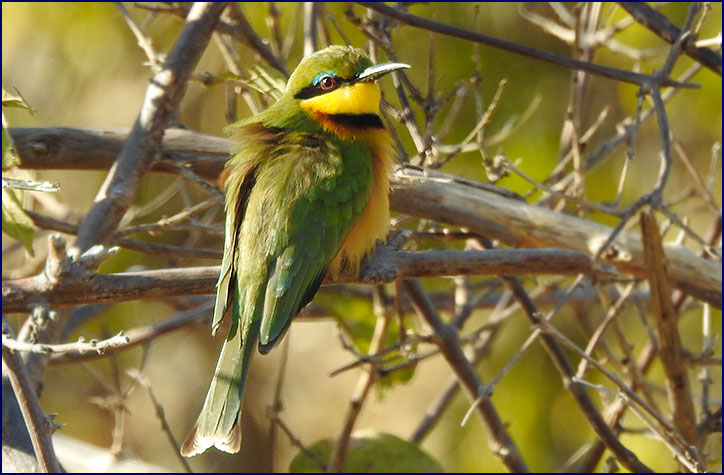
Little Bee-eater
|
The land
was mostly flat. The plains were interspersed with sparse bush and
stunted trees kept short by the elephants, though there were some
areas of forest. The sand roads we drove on were deep in places,
and would often split into several tracks going around the most
treacherous spots. Care was needed to avoid getting stuck.
A pair of black-backed jackals
were hunting in the tall grass; we watched as they leaped and
pounced, probably going after mice. These lovely canines look a
lot like large foxes. They are a chestnut brown color with black
backs and silvery stripes on their sides.
|
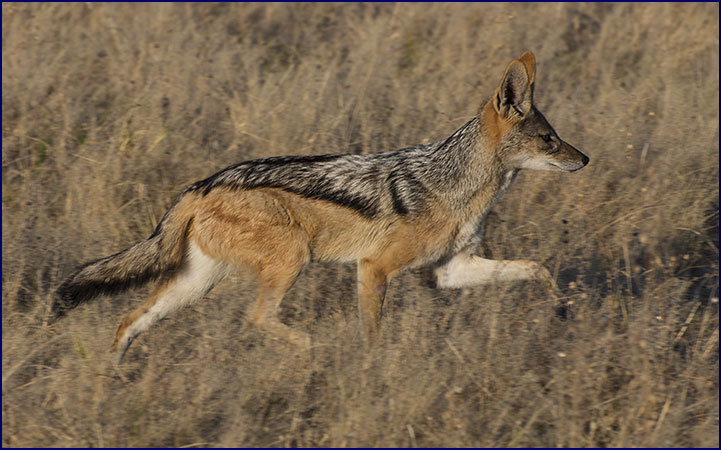
Black-backed
jackal
|
After a while Gee stopped the Landcruiser and got out,
saying he needed to check the tires. But then he disappeared
behind some bushes for a few minutes, before getting back in and
driving on. From then on, ‘check the tires’ became our
euphemism for ‘go behind a bush.’
A
lilac-breasted roller was perched on a twig near the road. These
brilliantly colored birds are absolutely beautiful, displaying a
rainbow of green, blue, turquoise, bronze, rose and of course
lilac. We waited, hoping he would fly and show the brilliant blue
of his wings, but he was huddled against the chilly air with his
feathers puffed up, not going anywhere.
A
family of warthogs ran through the tall grass, their tails held
straight up over their backs. Several impalas bounded across the
track in front of us. A yellow mongoose darted through the grass,
quick as a weasel, and another ran down the road ahead of us. A
butterfly very like our monarchs flitted around a flowering bush.
|
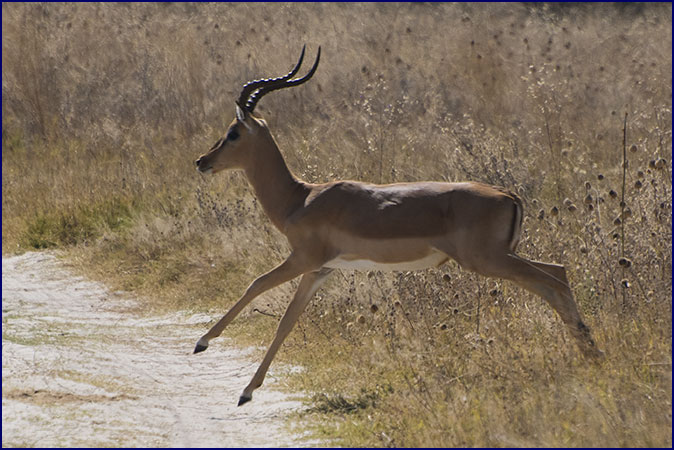
Impala
|
We drove along the edge of the Savuti
Marsh, which seemed an incongruous name as it was bone dry. I
am sure it must be a completely different environment in the rainy
season, but now it was a wide open plain of golden grass. Gee told
us that several cheetahs had been sighted here recently; the open
plain is the preferred habitat for these sight-hunting cats. I was
thrilled to hear this; cheetahs have become very rare and I had
not realized there were any left in northern Botswana.
We spotted a single dark round shape on
the horizon; even with binoculars it was too distant to identify.
Rob was sure it was a lone wildebeest, but Gee thought it was an
ostrich. When we drew closer of course Gee was proved correct.
With practice, we got better at identifying animals in the far
distance by their shapes. Wildebeests have a distinctive
triangular profile, high at the shoulder, while ostriches appear
as perfectly round black dots. Zebras have an oval shape that
appears grey from a distance, either light or dark depending on
the light. That tawny flash of gold you think is a lion usually
turns out to be in impala – they are everywhere.
A
beautiful Burchell’s sandgrouse was near the road, her dainty
feathers mottled with many shades of tan and brown. To our delight
she had four tiny chicks with her. The chicks froze as they are
taught by their mother and by instinct, sitting motionless,
depending on camouflage for protection. This worked well for the
first three, who blended in to the grass and virtually disappeared
from sight - but the fourth one ended up crouching in the sandy
roadway in plain sight. We got out for a look; they did not move,
even when we came very close.
|
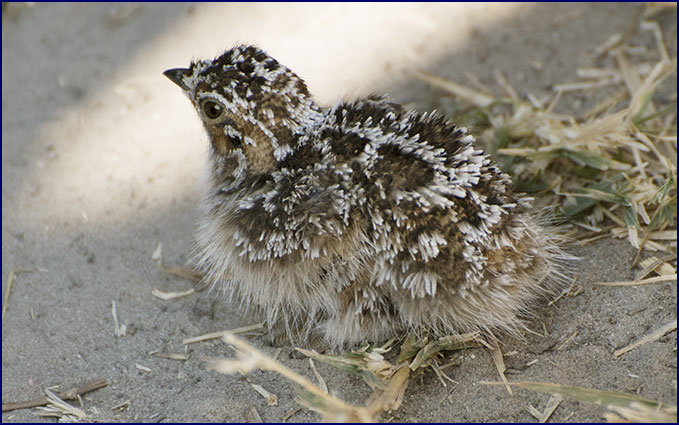
Sandgrouse
chick
|
We watched a herd of half a dozen giraffes with three
babies. One of the babies was quite small; we could see that his
umbilical cord was still attached - Gee said that meant he was
less than three weeks old. We were surprised at how big he was for
being so young. The baby giraffes are proportioned just like
miniature adults, unlike long-legged horse foals.
Several tsessebes stood near the road. These handsome
antelopes are fairly large, with a dark purplish-brown color, tidy
backswept horns, and intelligent goat-like faces. They are built
uphill, with front legs longer than the rear – Gee said this is
for endurance, a trait shared with other long distance runners
such as giraffes and hyenas. I noticed one of them had a broken
horn.
|
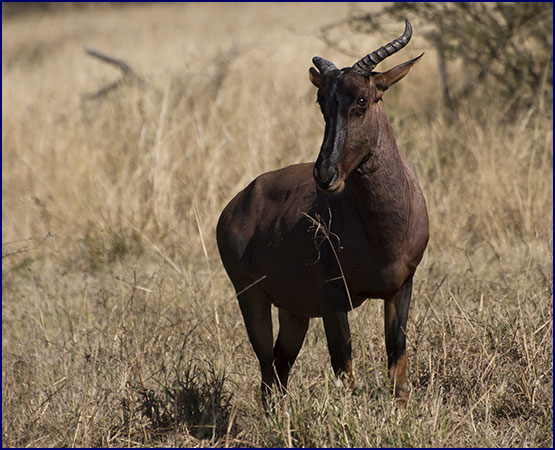
Tsessebe
|
A yellow mongoose stood up tall on its hind legs, peering
at us through the grass. Another one was on all fours in front of
its den, a burrow in an old termite mound. These slim-bodied
little creatures have long legs, bushy tails and refined faces.
They are sleek and beautiful, my favorite of the mongooses.
There was a waterhole on each side of the road, and we
stopped as a large herd of wildebeests crossed in front of us,
moving from one hole to the other. As they milled around drinking,
two calves, probably 4 or 5 months old, ran frantically back and
forth bawling pathetically, searching for their mothers. It was a
heartbreaking sound. Gee said their mothers had probably been
eaten by lions. The Circle of Life is harsh.
We stopped under some trees marked with a little sign that
said stretch point;
these are the only places you are allowed to get out of the
vehicle in Savuti. From there we had a view of the wildebeests;
the babies were still frantically running and bawling. Gee pulled
out some thermoses of hot water and supplies; we had our choice of
coffee, regular tea or bush tea. I was never exactly sure what was
in bush tea, but it seemed like an appropriate choice while on
safari - and it was quite good. We had cookies and rusks, hard
biscuits that are very good dipped in the bush tea or coffee.
We took turns going behind a large
tree about 100 feet away to ‘check the tires.’
Patty provided an alternate expression; she used to tell
her kids to ‘empty the teacup.’ Whatever one wants to call it,
Rob was the last one to visit the tree. While he was going about
his business we glanced over and noticed a huge bull elephant
silently strolling toward us, his route on a trajectory to go
right past where Rob stood. Rob was facing the tree with his back
toward the elephant, unaware of its approach.
|
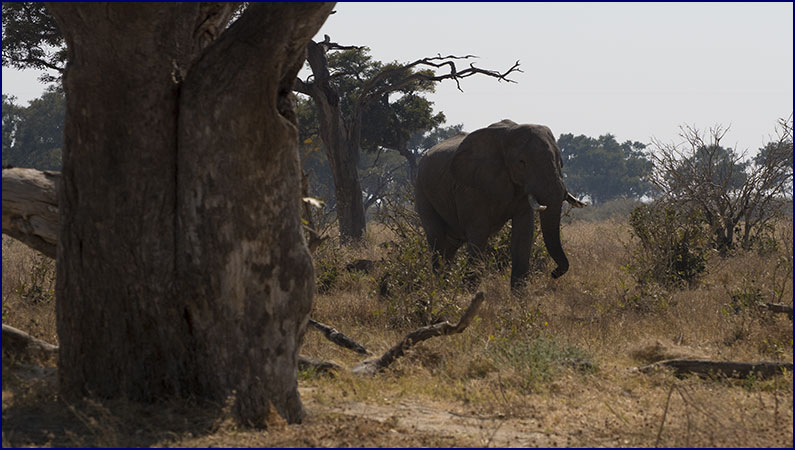
Rob's tree |
Gee instructed us all to get close to the Landcruiser:
‘Be one with the vehicle’ were his words. When Patty informed
him that Rob was still behind the tree, Gee looked a little
concerned. When Rob emerged and started toward us, still unaware
of the elephant closing in on him, we beckoned him to come be one
with the vehicle in a hurry! Elephants at the tea break. Awesome.
Rob endured a fair bit of teasing over the incident, and
‘be one with the vehicle’ became one of our catch-phrases for
the trip.
|
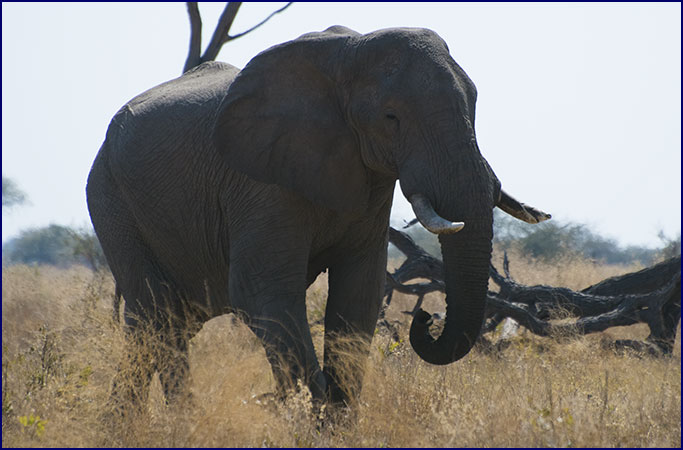
Be One with the
Vehicle |
On our way again after tea, we caught up with the male
ostrich we had seen from a distance earlier. He was black with
bright white tail feathers, and had huge strong legs, a long
skinny neck and a tiny head. It is difficult to appreciate how big
these birds are until you get close to them; he was enormous. In a
way he seemed sort of prehistoric, like he belonged with the
dinosaurs.
Gee
pointed out some of the native trees to us. The most prevalent
were the mopanes; although they can grow into lovely tall shade
trees, most of them never get the chance because they are eaten
off to shrubs by the elephants. He also showed us the camelthorn
acacia, big trees with spreading branches and a flat crown, the
quintessential image of Africa. Another tall beautiful tree he
pointed out was the rain tree. I have heard various reasons why it
has this name; the seedpods hanging down look like rain, when the
wind blows the rattling pods sound like rain – but Gee offered
another explanation. He told us there is a bug called the frog
hopper that sits in the branches and ‘rains’ liquid down
below. Ugh.
Gee
also showed us some of the local plants and herbs. He picked some
wild sage, and we enjoyed its pungent scent. He also showed us
some purple pen weed, which had an awesome smell; he told us that
ladies sometimes boil the roots and drink it to get rid of
unwanted pregnancies.
|
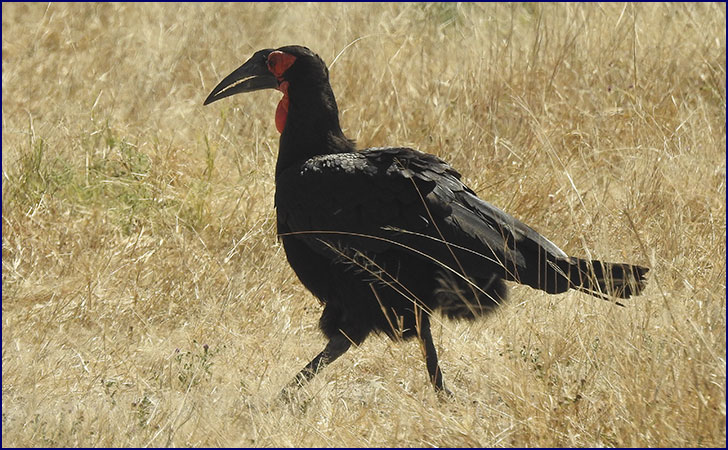
Ground
Hornbill
|
We
watched, fascinated, as a group of four ground hornbills walked
through the underbrush. These unattractive large black birds are
about the size of a turkey. They have red featherless faces and
enormous bills. Though they can fly, they spend most of their time
on the ground. They are an endangered species, and reproduce
slowly, only breeding once every four years.
On
the way back to camp we passed a huge baobab tree. Gee told us it
is called the Bushman’s Baobab, because it is near Bushman’s
Rock. Baobabs are grand and unique trees, with thick trunks and
tiny branches. It was like an ancient living monument. This
magical tree was quite near to camp, but I was sure I had not seen
it before on the previous trip.
|
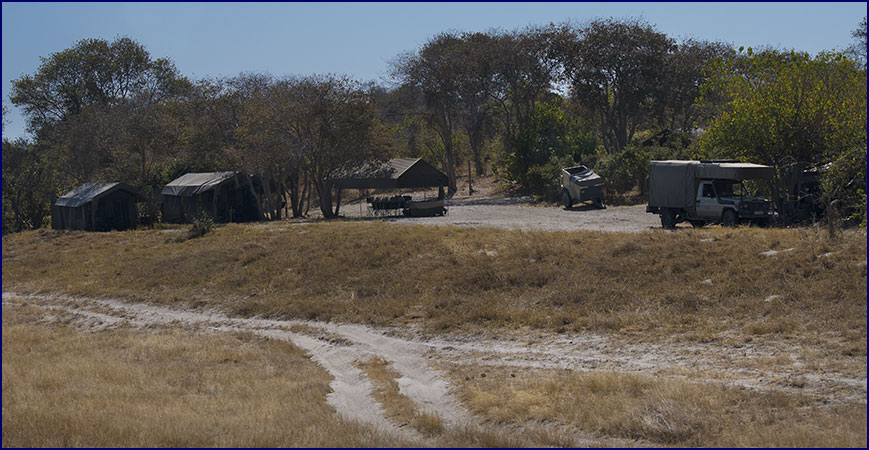
Savuti
Camp
|
As
we drove across the dry riverbed and into camp, Phillimon was
there waiting for us, holding a tray with goblets of sweet iced
tea. The guys served us a delicious lunch, complete with salad and
fresh baked bread. The meals were buffet style; we would serve our
plates and then sit around the long table. Gee always ate with us,
telling stories and answering questions. There was a variety of
condiments on the table, such as chutney, hot sauce, sweet chili
sauce and honey. The water pitchers had little beaded covers to
keep any errant insects out. Most importantly, the food was always
excellent.
After lunch the guys brought hot water to our tents for the
bucket showers. We found our towels folded into heart-shapes on
our beds. This was a swanky place!
We
set out on our afternoon drive around 3:30. Red-billed hornbills
were everywhere, flying in their distinctive swooping patterns;
they were like Zazu from The Lion King. Their
calls, repeating pairs of ascending notes conveying a sense of
urgency, reminded me of a musical score from an action movie. A
tawny eagle sat in a tree, surveying the world from his lofty
perch. He looked proud and regal, feathers tan, brown and bronze
in the sun, and a light gleaming in his eye.
|
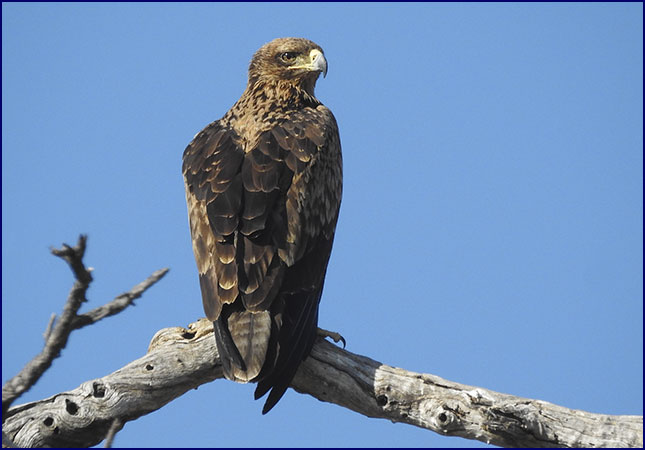
Tawny Eagle |
A tiny dwarf mongoose stuck his head up from behind a
termite mound and gazed at us; he was dark brown with red eyes and
a perky expression. We were able to get quite close to an impala
doe; she had a beautiful deer-like face with large liquid eyes and
ears tipped with black. A very large lone wildebeest bull grazed
nearby; Gee said he was patrolling his territory.
|
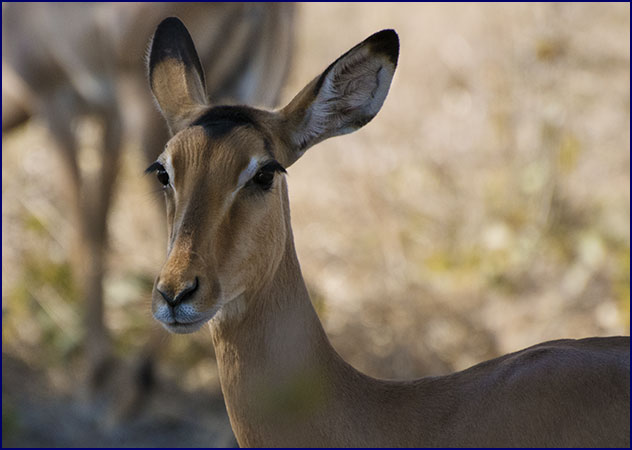
Impala
doe |
Gee heard something while driving through some mopane
trees; he stopped and turned off the engine. A Bradfield hornbill
was sitting in a small tree beside the road; he was a dark grey in
color with a big orange bill and orange eyes. He was larger and
more handsome than his red-billed cousins. And he was singing his
heart out! He tilted his head back and pointed his substantial
bill straight up in the air, and sang out in a loud and poignant
voice. His song filled the air. Then his voice was joined by
another hornbill, and then another; they were having a singing
contest, marking their territory and competing with one another
for the females. There were five males altogether, singing for all
they were worth. It was marvelous.
“My
god,” said Gee, “This is amazing!”
He told us he had never seen or heard anything like it. We watched
and listened for a long time, feeling very fortunate to be
witnessing this spectacle. We called it the Hornbill
Choir.
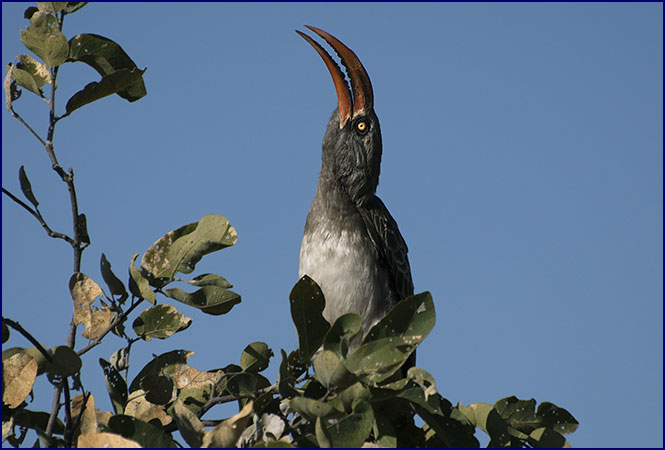
Participating
in the Bradfield Hornbill Choir.
|
We passed a herd of giraffes. Gee told us the collective
noun for a group of giraffes is a tower if they are standing still, but it is called a journey
of giraffes if they are moving. Before long we came to a
series of pans (shallow lakes or waterholes) which I remembered
from our last trip.
There were two bull elephants drinking at the first
waterhole. One was huge with a very long trunk, and was
glistening wet with mud; we had apparently arrived just after he
took a mud bath. The other was slightly smaller and considerably
cleaner. We parked just across the water from where they stood,
and settled down to watch the show. A giraffe was waiting his turn
to drink, but after a while he gave up and left.
Suddenly the big bull came straight toward us, crossing the
water and climbing the near bank with a toss of his head. He was
huge - Gee said the big males weigh over six tons – and he was
very close. He looked at us and snaked his trunk around his face,
curling and uncurling it and waving it in the air. Would we need
to make a hasty retreat?
Then the elephant danced for us. He started moving in a
slow shuffling pattern, swinging and crossing his legs back and
forth and doing a slow-motion pirouette. He swayed rhythmically
from side to side, curling his trunk around his tusks like a big
python, and then swinging it in circles, looking straight at us
while he performed. We watched in awe as he danced to some inner
music that we could not hear. Finally, show finished, he stood
there a few minutes resting his trunk over one tusk in a cavalier
manner. Then the huge elephant turned and walked away, his smaller
companion following.
There were half a dozen elephants at the second pan, but
they seemed spooked by our vehicle and left in a hurry. Moving on
to the third watering hole we found a large family group of ellies
just coming down to drink. Perfect timing! We drove around to the
opposite side where we could watch them from across the water.
It was a breeding herd with several big females, about ten
half-grown youngsters, and three babies. The smallest one seemed
quite young - Gee estimated that it was about 7 months old. They
all lined up at the edge of the water, drinking leisurely. We
could hear the low stomach rumble they use to communicate with
each other; this sound carries for miles, often at frequencies too
low for humans to hear. Several giraffes moseyed by in the
background.
Elephants have a matriarchal society; the dominant female
runs the show. A breeding herd consists of all the adult females
and youngsters in an extended family. The females have a very
close-knit society, and they share in caring for the babies.
Anyone who has spent time observing elephants can’t help but be
impressed by their intelligence and empathy.
The males are forced to leave the herd when they approach
maturity; the females don’t want them around anymore. These
outcasts will hang out with other males and form small bachelor
herds. There was one adolescent male at the pan who was being
pushed out of the herd; every time he tried to join the others the
matriarch would chase him away - it was time for him to make his
own way in the world.
Once the elephants finished drinking, several of the
rowdier youngsters waded into the deeper part of the water and
began to play and splash. They lay down and rolled, and then
sucked up water in their trunks and sprayed each other. Several of
the smaller babies soon joined in the fun, sitting and splashing
with only their heads above water. It was like an elephant spa!
One of the adolescent males strutted along the shore, obviously
feeling very important.
|
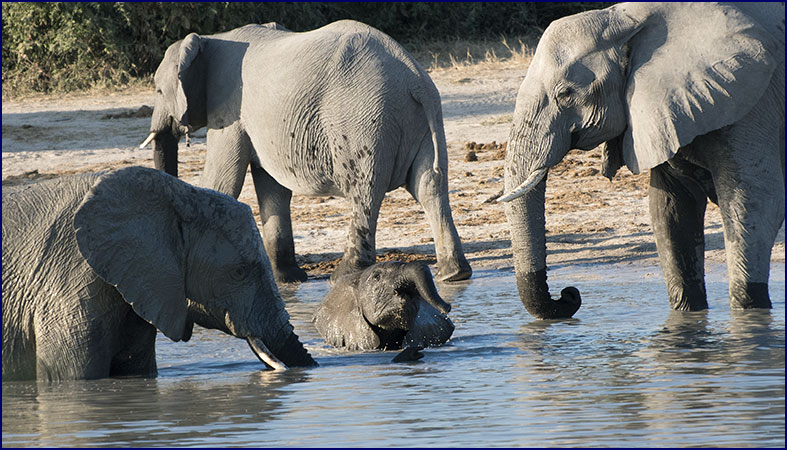
The Elephant
Spa
|
After a while the ellies moved on to the next part of their
spa; there was a big dust wallow near the waterhole, and the herd
made full use of it They took very thorough dust baths, some of
them laying down and rolling in the deep powdery dirt, and others
sucking up great trunkfulls of it and blowing it all over
themselves. Once thoroughly coated, they marched away in a
dignified manner.
As we left the pans we caught a flash of movement; a whole
group of banded mongoose, one of the larger types, was moving
through the grass. Their striped coats blended in perfectly with
the underbrush while they scuffled along searching for beetles and
millipedes. The collective noun for a group of mongooses is a business,
which makes sense as they are so active and busy. I have always
found them very hard to photograph, because not only are they
never still, but there is something about their subtly striped
coats that seems to defy the autofocus on my cameras.
|
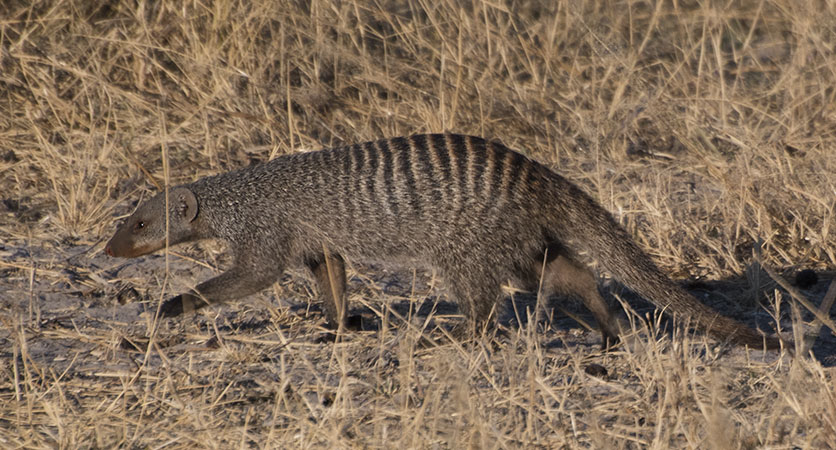
Banded Mongoose |
We were getting ready to head back toward camp when Gee got
a call; the cheetahs had been sighted! Hang on, he told us, and he
drove fast, flying across the plain as we bounced about in the
back of the vehicle. We were required to be back to camp by 6:30
pm and the cheetahs were some distance off, so we didn’t have
time to hang about.
As we accelerated across the plain
a young bull elephant took offense at our haste. Even though we
passed several hundred feet from him, he waved his trunk and
trumpeted angrily, sidestepping and flapping his ears in anger. We
laughed at his antics, and dubbed him the Road Rage
Elephant.
We found two cheetahs sleeping in the
grass on the edge of the open plain. There were several other
vehicles there; we parked where we had a good view of one of the
slender cats, lying flat out on his side sleeping. Every once in a
while he would look up at us with a slightly annoyed expression
before putting his head back down to nap. We watched him as the
sun went down.
|
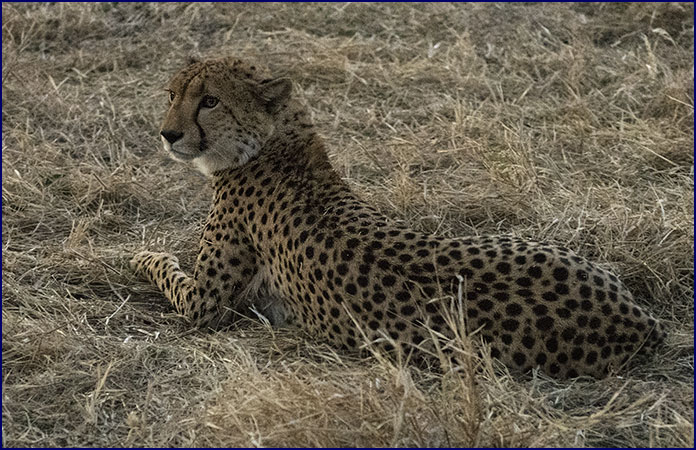
Beautiful,
elegant cheetahs. |
Cheetahs hunt by sight and run down their prey, which is
why they like the open plains. As everyone knows, they are very
fast, able to run up to 120 km per hour, but they can only sustain
their speed for short distances and then they have to rest. They
are lean and fragile cats, built like a greyhound, not fighters at
all. Often hyenas or lions will steal their kills. Sadly, these
beautiful endangered cats are very rare now.
As
the other vehicles started leaving, we were able to move to a
better spot to watch both cheetahs. They were starting to get a
little restless; one would raise his head and look around a bit,
and then the other would do the same. They looked like they might
get up at any minute, but it was close to 6:30 so we didn’t have
much time.
The last of the other vehicles
left, but Gee waited a few minutes more, hoping for action. Then
to our delight one of the cheetahs reluctantly stood up and walked
over to a tree to mark his territory. We were elated to have had
the chance to see these elegant graceful creatures.
Gee headed back to camp, driving fast, stopping just once
briefly to check for leopards when he noticed the impala and
wildebeest all looking in one direction with alarm. It was getting
dark when we drove up the riverbed and pulled into camp a few
minutes after the 6:30 curfew. The dead tree stood starkly against
the rose, mauve and blue sky. Phillimon was there with our glasses
of tea, and Parker had warm moist cloths for us to wash off the
road dust. We could see the lanterns lighting the way to the
tents, and the campfire beckoned. All was right with the world.
We sat around the campfire and watched the stars come out.
The African night sky is unbelievable. The Milky Way stretched
above us, its stars gleaming like diamonds thrown across the sky,
shining against the depths of time. Scorpius rode high overhead,
and the Southern Cross watched over us. With the clear dry air and
no light pollution from towns or cities, the stars were brilliant
right down to the horizon - truly far more spectacular than we
ever see in the northern hemisphere. I set up my tripod and took
some long-exposure photos of the night sky.
|
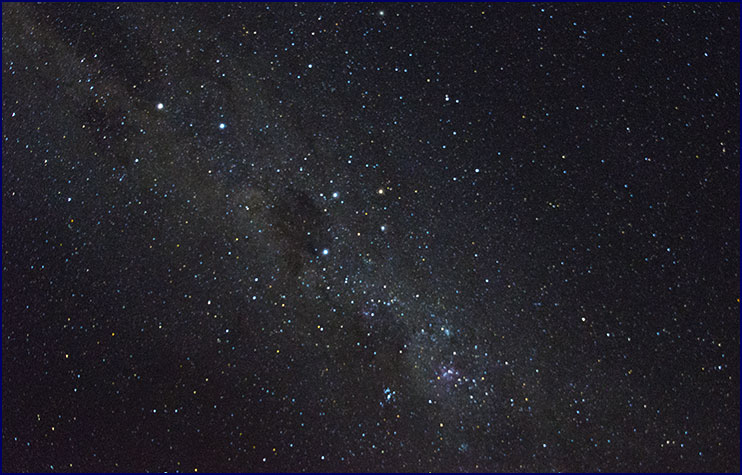
The Southern
Cross and the Milky Way |
We discussed the highlights of the day, and which were our
favorite sightings. Some said the hornbill choir and some said the
elephant spa. For me it was a toss-up between the honeymooning
lions and the cheetahs. But wait, what about the dancing elephant?
And the baby giraffe? We had seem so many incredible things - it
was hard to choose just one.
After much banter around the
campfire, I called for everyone’s attention and announced I had
something to say. Everyone looked at me expectantly, waiting for
something profound. Keeping with the long-standing Dawson
tradition of making up bad limericks while on vacation, I recited:
“To
our tea break an elephant came
He
did not appear to be tame.
When
Patty told Gee
Rob
was behind a tree,
He
shrugged, and said “Oh, what a shame!”
Pula came to the fire and announced dinner, taking
everyone’s minds off the bad poetry. The main course was roast
beef, and it was excellent. We told Gee that if there was any food
left over we hoped the guys would eat it, because it was much too
good to be burned. He replied that it would have to be cooked much
more; his people eat a lot of meat but they like it really well
done with no pink in it, especially for beef. Perhaps the spirit
of the animal might still be in it? Gee told us he does not eat
pork at all; we weren’t sure if it was because of religion, or
if he just doesn’t like it.
We sat around the fire again after
dinner, talking some more about our fantastic day. Parker shyly
asked permission to put bushbabies
in our beds, referring to the hot water bottles – we
all gave him an enthusiastic yes.
Gee told us stories about life growing up on the island in the
Delta, and about going to guiding school. We made plans to go on
an all-day drive the next day, and then retired to our tents. We
let the animal nightly noises lull us to sleep.
|